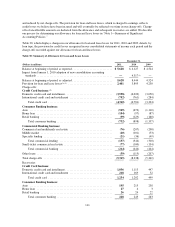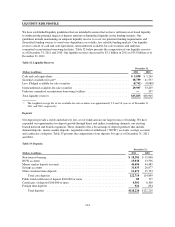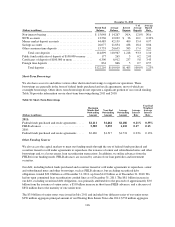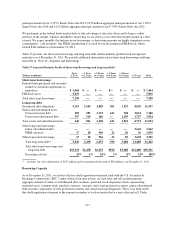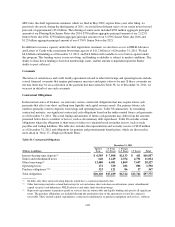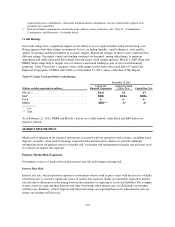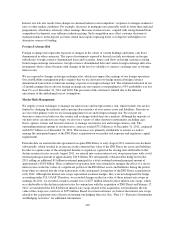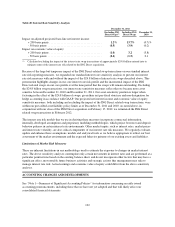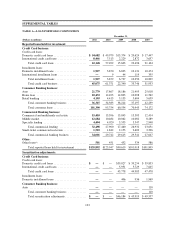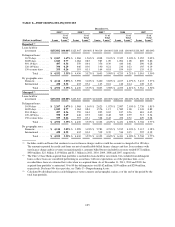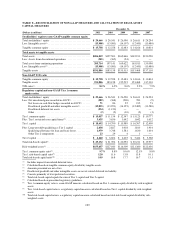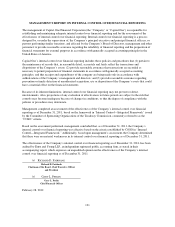Capital One 2011 Annual Report Download - page 141
Download and view the complete annual report
Please find page 141 of the 2011 Capital One annual report below. You can navigate through the pages in the report by either clicking on the pages listed below, or by using the keyword search tool below to find specific information within the annual report.Market Risk Measurement
We have prescribed risk management policies and limits established by our Asset/Liability Management
Committee. Our objective is to manage our asset/liability risk position and exposure to market risk in accordance
with these policies and prescribed limits based on prevailing market conditions and long-term expectations.
Because no single measure can reflect all aspects of market risk, we use various industry standard market risk
measurement techniques and analyses to measure, assess and manage the impact of changes in interest rates and
foreign exchange rates on our earnings and the economic value of equity.
We consider the impact on both earnings and economic value of equity in measuring and managing our interest
rate risk. Our earnings sensitivity measure estimates the impact on net interest income and the valuation of our
mortgage servicing rights, including derivative hedging activity, resulting from movements in interest rates. Our
economic value of equity sensitivity measure estimates the impact on the net present value of our assets and
liabilities, including derivative hedging activity, resulting from movements in interest rates. Our earnings
sensitivity and economic value of equity measurements are based on our existing assets and liabilities, including
derivatives, and do not incorporate business growth assumptions or projected plans for funding mix changes. We
do, however, assess and factor into our interest rate risk management decisions the potential impact of growth
assumptions, changing business activities and alternative interest rate scenarios, such as a steepening or flattening
of the yield curve.
Under our current asset/liability management policy, our objective is to: (i) limit the potential decrease in our
projected net interest income resulting from a gradual plus or minus 200 basis point change in forward rates to
less than 5% over the next 12 months and (ii) limit the adverse change in the economic value of our equity due to
an instantaneous parallel interest rate shock to spot rates of plus or minus 200 basis points to less than 12%. The
federal funds rate remained at a target range of zero to 0.25% during 2011. Given the level of short-term rates as
of December 31, 2011 and 2010, a scenario where interest rates would decline by 200 basis points is not
plausible. In 2008, we temporarily revised our customary declining interest rate scenario of 200 basis points to a
50 basis point decrease, except in scenarios where a 50 basis point decline would result in a rate less than 0% (in
which case we assume a rate scenario of 0%), to compensate for the continued low rate environment. Our current
asset/liability management policy also includes the use of derivatives to hedge material foreign currency
denominated transactions to limit our earnings exposure to foreign exchange risk.
Table 40 shows the estimated percentage impact on our adjusted projected net interest income and economic
value of equity, calculated under our base case interest rate scenario, as of December 31, 2011 and 2010,
resulting from selected hypothetical interest rate scenarios. Our adjusted projected net interest income consists of
net interest income adjusted to include changes in the fair value of mortgage service rights, including related
derivative hedging activity, and changes in the fair value of free-standing interest rate swaps. In measuring the
sensitivity of interest rate movements on our adjusted projected net interest income, we assume a hypothetical
gradual increase in interest rates of 200 basis points and a hypothetical gradual decrease of 50 basis points to
forward rates over the next twelve months. In measuring the sensitivity of interest rate movements on our
economic value of equity, we assume a hypothetical instantaneous parallel shift in the level of interest rates of
plus 200 basis points and minus 50 basis points to spot rates in measuring the sensitivity of the valuation of our
economic value of equity.
121


